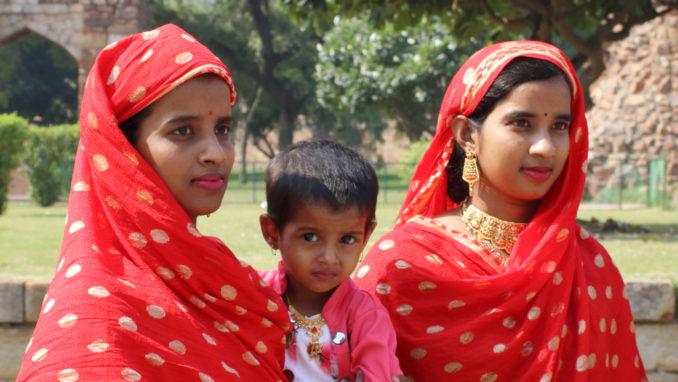
© Colin Cross, Going Postal 2022
I thought long and hard(ish) on how I could start off a series of “Postcards” about our trip to India. The whole thing came about following an off the cuff remark whilst discussing, with my younger daughter, her latest travelling adventure. She was going to be doing Asia and was considering stopping off in Sri Lanka as one of her ports of call. I’d said (somewhat flippantly) that I wouldn’t have minded visiting there, especially if there was some cricket to be seen, but I also cautioned against her going, given the political climate at the time. She did her research and decided to take my advice, instead opting for an extended trip to India. “Why don’t you and mum come out and join me” she asked. I’d harboured the dream of visiting India as a younger man, during my “hippy” days, that was as far as I’d got with it, but the more we thought about it and the more we weighed it up against the post “Covid” political, social and financial atmosphere, the more the idea appealed to me. Mrs C wasn’t so keen, but she also knew it would be another “trip of a lifetime” and although she was worried about the food, the water and the possibilities of illness she nevertheless, albeit slightly reluctantly at first, came to accept it as a possibility and eventually embrace it as an actuality. I won’t bore you with the planning, or how we went about organising the whole thing. Instead I hope to give a “flavour” of the bits of the country we saw, its people, its history, its food and its extremely diverse culture. I’ve long admired Jon Steinbeck’s writing and a paragraph from “Sweet Thursday”, one of his shorter novels, has always been a favourite “quote” of mine. I hope that by paraphrasing it here my reader will get a feel for the utter chaos that is Delhi.
Delhi in Uttar Pradesh in India is a poem, a stink, a grating noise, a quality of light, a tone, a habit, a nostalgia, a dream. Delhi is the gathered and scattered, tin and iron and rust and splintered wood, chipped pavement and weedy lots and junk heaps, food stalls and markets of corrugated iron, monuments, restaurants, shops, tarpaulin covered dirt floored hovels, little crowded groceries and tuk-tuks and scooters and buses and cars and cows and (everywhere) people, . Its inhabitant are, as the man once said, ” gratingly poor, incredibly wealthy, resilient, fatalistic, industrious, lazy, resigned and religious,” by which he meant Everybody. Had the man looked through another peephole he might have said, “Saints, sinners, angels, devils, martyrs, atheists and holy men”, he would have meant the same thing.”
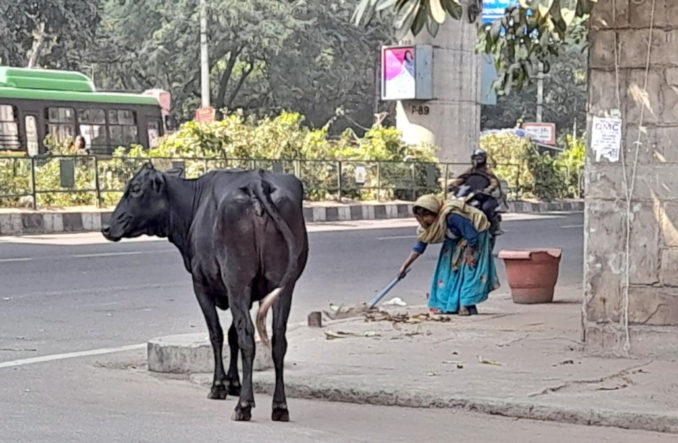
© Colin Cross, Going Postal 2022
We landed on the morning of 24th October, which just happened to be Diwali, the middle day of the five day “Festival Of Lights”. We’d flown business class, after entering a bid for an upgrade, so we weren’t too tired. The trip to the hotel by taxi was a longish ride, but as soon as we hit the city all the things we’d heard about started to become a reality. The traffic was mad and every time we were held up in it beggars and hawkers would approach; transvestites, young men and women, small children carrying crying babies begged or peddled trinkets, small paper plates of coconut and fruit or sweets. The transvestites, who I didn’t manage to photograph for fear of offending anyone, seemed to be coquettish and playful. Children in buses, dressed in their Sunday best and probably travelling to various holy sites and parks seemed particularly taken with them. It’s something of a shock to see a grown man, made up in full traditional female dress and wearing lots of jewellery, banging quite aggressively on car windows whilst almost at the same time bashfully giggling at the playful taunts of the youngsters on the buses. The hotel, where we were staying for the first three nights was relatively clean and functional. As with everything in India (we came to learn), expectation cannot be applied using “European” standards, to do so would be to be constantly either extremely disappointed or totally flabbergasted. As is my wont, I decided to have a little explore of the Karol Bagh area before freshening up; A woman sweeps her families bit of pavement whilst a cow looks on impassively. An air conditioned electric bus plies its trade on the thoroughfare and the Metro is carried above the road on the concrete pillars. Welcome to Delhi. Left to our own devices, as our “Golden Triangle Tour” proper didn’t begin until the 26th, we struck out on our own, only for the day to end confusion. Most restaurants and shops were closed, taxis were few and far between and we got a bit lost in an area called Connaught Place, we ate an approximation of an Indian meal at one of the more salubrious hotels and ended up paying four hundred and fifty rupees for a terrifying (Mrs F’s words) tuk-tuk ride back to the hotel, an enormous amount of money (a fiver) in the general scheme of all things tuk-tuk, but a valuable lesson learned.
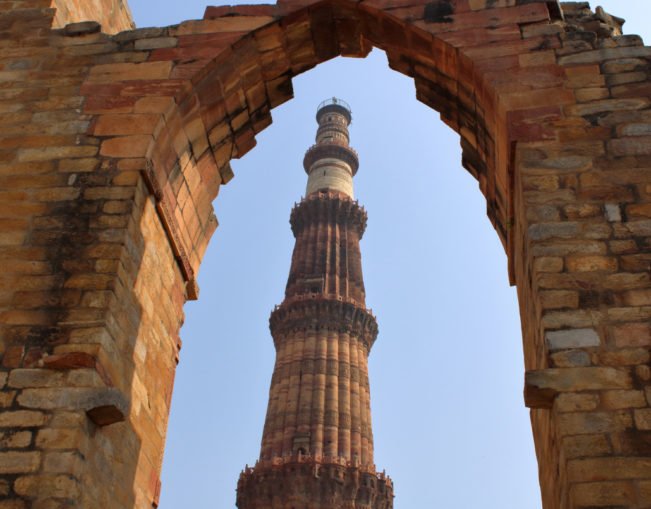
© Colin Cross, Going Postal 2022
Day two was set aside for a bit of site seeing; Following breakfast at a branch of Haldiram’s (more of which in later posts) we met up with our “road trip” guide who was happy to arrange transport for us and give us some ideas about the places we might like to see. Our Sikh driver duly arrived, complete with a fully air conditioned and leather upholstered SUV and proceeded to navigate his way through the chaos of Delhi traffic, past the Temple of The Monkey God Hanuman (about five times) before dropping us at Lal Kot Fort, one of the oldest in Delhi and the site of the thousand year old, 230 feet high “Victory Tower” known as Qutb Minar. The scale is breathtaking, as is the intricacy of the carvings which adorn the sandstone it’s built from. In the grounds there’s an iron pillar, which is also over a thousand years old, it has never rusted and remains particularly resistant to corrosion of any kind “a testimony to the immense skills of ancient Indian Ironsmiths” as the blurb goes. I found the whole place more than fascinating. As we’d come to learn over the following week or so, the heritage (religious and cultural) and architecture of India are a rich and powerful testament to its long and often turbulent history.
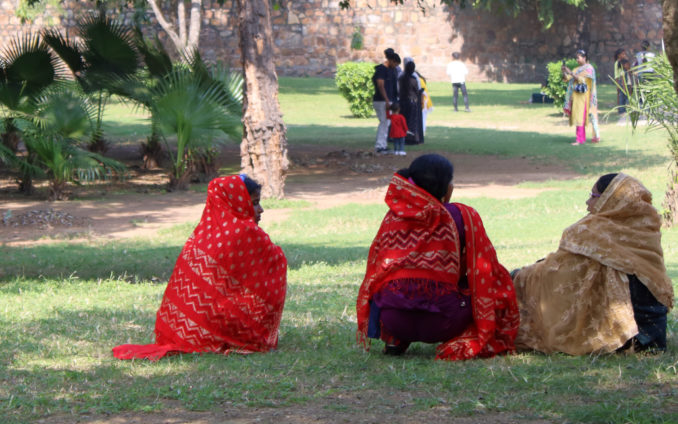
© Colin Cross, Going Postal 2022
Indian visitors to historical sites are charged between fifty and one hundred rupees to gain entry, foreign visitors, more often than not, will pay five hundred (where there’s a fee to be paid). We were betting around ninety five rupees to the pound, so although the contrast is great, nothing is too expensive. At this point we were considering ourselves to be lucky to have arrived when we did, there were lots of people, but they were mostly dressed in their most colourful “holiday” attire and jewellery, especially the women and children and, much like people all round the world, those that could afford to were taking advantage of the festival to get out and about, to be seen and be seen and to sit under a shade tree and have a bit of a gossip. My daughter was very popular too, with several families asking if she’d mind being photographed with them and their children. She’s blonde and light skinned, a rare sight even in the heart of this immense city and she was happy, at first, to do so.
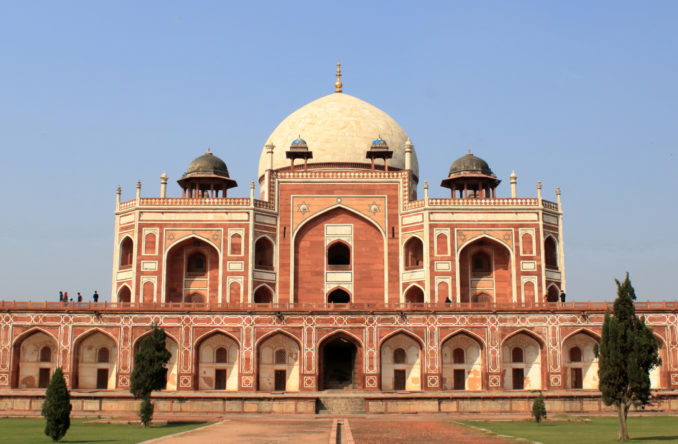
© Colin Cross, Going Postal 2022
From Qutb we returned to our car and proceeded, via the now ubiquitous Hanuman roundabout (a spectacular sight in itself) to Humayans tomb, which was commissioned by Empress Bega Begum, Humayans first wife, in 1558. Although we were to see many incredible buildings, forts, mausoleums, palaces and other examples of ornate Indian and Mughal architecture, this building stands out for me as the “must see”. It was designated a World Heritage Site in 1993 and since then has been fully and faithfully restored to its former glory, although the ornate carpets and curtains, which once adorned the inner sanctums, haven’t been replaced. At its centre are the graves of Humayan and Empress Bega, surrounded by the tombs of a large number of other worthies of the time and later. The whole place is fascinating, if you like this type of thing, all four sides are exactly the same as are the gardens (now mostly lawns and trees) emanating from the building itself and incorporate, within the artwork and intricate carving, images from Islam, Hinduism, Christianity and Judaism. I took a number of photographs, but it’s one of those places which can only really be appreciated by actually visiting it.

© Colin Cross, Going Postal 2022
From Humayans tomb we set off to visit India Gate, a memorial to those eighty four thousand Indian servicemen who died between 1914 and 1921, fighting in the 1st World War and in other conflicts including the 3rd Anglo-Afghan War. Designed by Sir Edwin Lutyens, it’s an imposing thing and well worth a visit if you’re in Delhi, however, it attracts huge crowds during holidays and can be quite intimidating. Not surprisingly we passed Hanumans Temple again, where Mr Singh, our excellent and very calm driver told us, once again, it was the temple of The Monkey God. There’s no charge to visit India Gate and it’s surrounded by parkland, where hawkers and food vendors offer their wares, which makes it very popular. Here we saw a bit of a darker side to the “please can we get a picture with you”; teenage boys and young men pestering my daughter to be photographed with them and their friends and others surreptitiously photographing her, whilst pretending to be taking selfies. We felt it best to leave, I was beginning to get angry at all the attention but had been warned to avoid confrontation. Apparently it’s a modern cultural phenomenon, apart from the very poorest (more of which in other posts) everyone seems to have the very latest mobile phones and using them to take photographs seems to be almost an obsession. Two thousand two hundred and fifty rupees, including tip provided excellent value for money for the services of the unflappable Mr Singh, cheap at half the price. Having freshened up (hot water was only available by contacting reception, as the boiler’s only fired up on request) we were joined for a pre-tour briefing by our guide and the other couple who made up our party, before our first visit to a proper Indian restaurant.
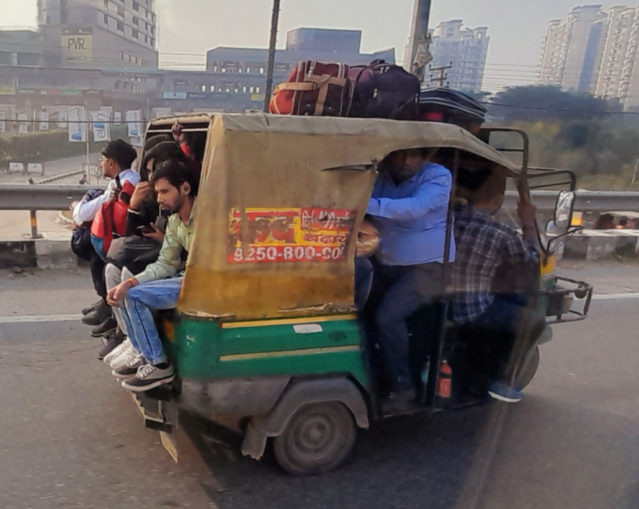
© Colin Cross, Going Postal 2022
The tuk-tuk is everywhere, there are literally thousands of them, each with a driver, or so it seems, who’s more intent on ignoring any sensible rule of driving than the last one. They think nothing of performing U-turns in moving traffic, reversing back against the flow of traffic or even going around roundabouts whichever way is the shortest or most advantageous to stealing a march on the driver next to them. The blaring of horns is relentless. Two people can fit comfortably in most Delhi tu-tuks, although there are newer versions more “luxurious” versions which are slightly more spacious. It isn’t unusual to see them with a slightly larger passenger load, but I think this one, with at least ten people on board, but possibly as many as thirteen including the driver, was the most heavily laden I saw.
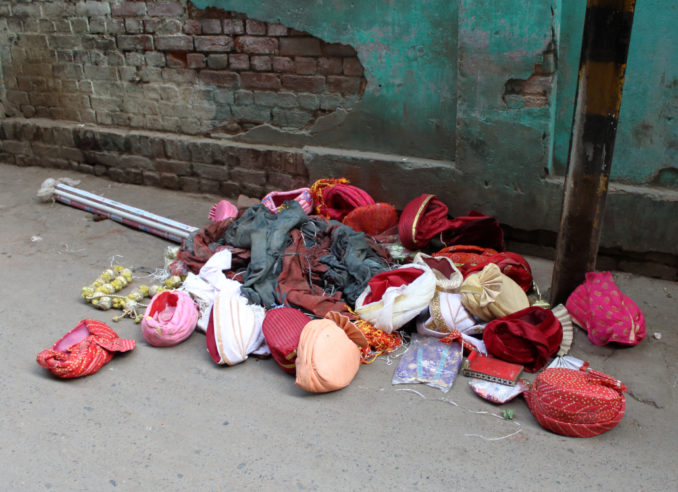
© Colin Cross, Going Postal 2022
Day three saw us, along with our guide (Avi), taking a trip on The Metro from Karol Bagh station to “Old Delhi”. Avi had warned us to expect the unexpected, be prepared for some shocks, keep an open mind and not to engage with beggars or hawkers. Once they think they have your attention, they’re relentless in pursuing you, one young woman walked with us for maybe four hundred yards, tugging gently now and again at one or another of our sleeves. It’s very hard to resist the temptation to give because it’s clear they have so little, but it really is frowned upon. Eventually they get the message and set off to look for a more receptive audience. He was right about expecting the unexpected, everywhere there were “fairy” lights and flower garlands, due to the festival, miles of electric wires, with macaques playing amongst them, ran along and across the narrow streets, men bathed at communal taps, scooters sped along the narrow lanes, I saw one group of men “mining” the sewer system for grains of precious metal. Food stalls are everywhere and always busy, women sweep the litter from in front of their own space into the space next door, while men squat, gossip and spit the remains of five rupee chewing tobacco sachets at your feet. We ate breakfast at a Paratha stall, one of the oldest such businesses in the city, which turned out to be an adventure in itself and something Mrs C will never, ever forget.
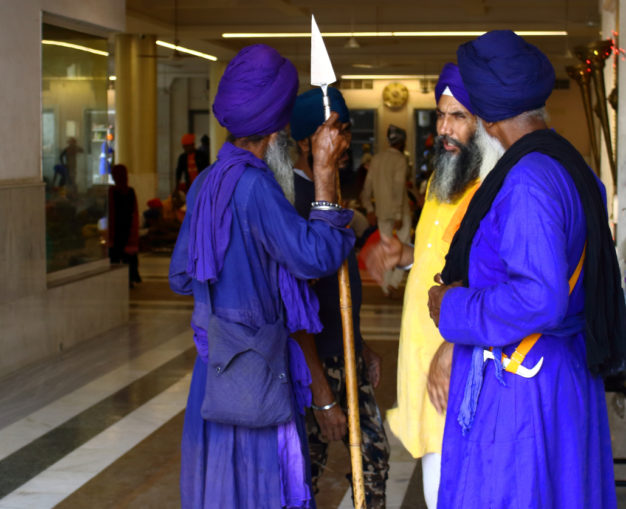
© Colin Cross, Going Postal 2022
The highlight of “Old Delhi”, at least for me, was a visit to the Gurudwara Sis Ganj Sahib, one of the oldest Sikh temples in Delhi, having originally been a shrine to Guru Tegh Bahadur, built in 1783. It’s now a place of pilgrimage for Sikhs from all over India and provides free meals for all comers, whatever their religion (or not) each and every day. Protocol is very important, we had to h remove our shoes, symbolically wash our feet and hands and cover our heads before entering this holy place.
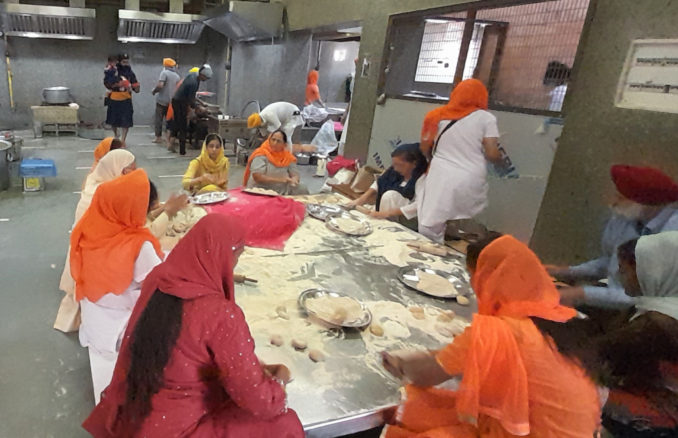
© Colin Cross, Going Postal 2022
The kitchens are fascinating, with female volunteers moulding, rolling and cooking chapati’s whilst male volunteers cook vegetable curries and rice in huge steel cauldrons. There are rooms for both pilgrims and priests, the prayer room is very ornate, live music is relayed throughout the building and the copy of the Guru Granth Sahib (the Sikh holy book) has its own, guarded bedroom. A fascinating if short insight into a very spiritual and mysterious religion and some of its followers, many of whom are warriors by nature.
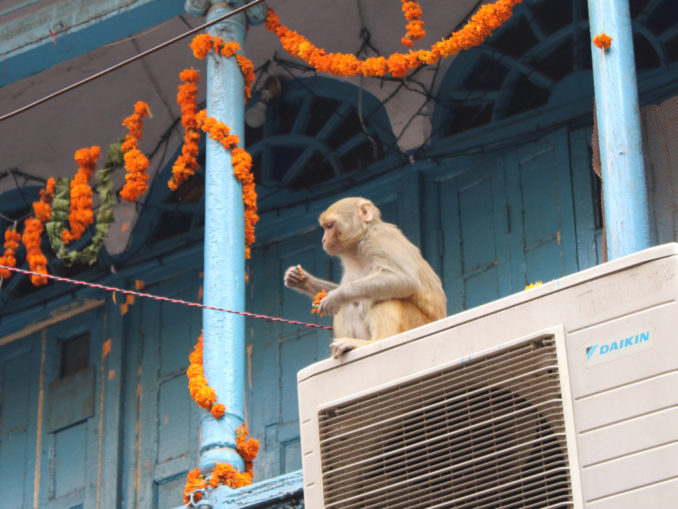
© Colin Cross, Going Postal 2022
We left the Sikh temple and took a ride in a couple of rickshaws, powered by a couple of ageless, wiry old men with deeply lined faces. They could just as easily have been seventy years old as fifty, but this was both their life and their means of earning a living, I couldn’t say they looked on us tourists with anything other than the detachment they save for the majority of their customers 9at a guess) but they got us from A to B, allowing us to observe life as we went along. Above us the macaques feasted on Diwali marigold garlands. Much of Hinduism is dedicated to the preservation of life, especially the lives of animals, hence the sacredness of the cow (there are no bulls, only male cows) and it’s considered both fitting and auspicious that these small monkeys, who survive happily alongside their fellow primates, benefit just as much as man does from the celebration of Diwali.
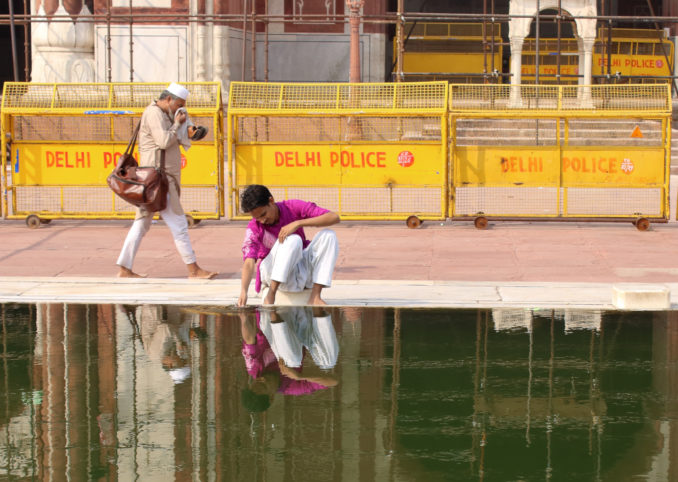
© Colin Cross, Going Postal 2022
On the same morning we visited the The Jama Masjid Mosque, which was completed in 1656, another fascinating building, although not somewhere I found myself sharing the same affinity with as the Sir Ganj Sahib, which, on reflection is quite strange. The concept of modern, “radical” Islam and recent interpretations of its scriptures have tainted the religion in many minds, but, as I was going to find out, especially in India this hasn’t always been the case. Hindus, Muslims and members of other faiths had lived in almost complete harmony (notwithstanding wars of conquest for territory and riches) for many years, so much so that one Mughal Emperor founded a composite religion in a vain attempt to prove however one worshipped, one was worshiping only one God. It’s probably a sad reflection of the human condition that, following his death, this “new” religion disappeared without a trace.
Next time; A Road Trip
© Colin Cross 2022



